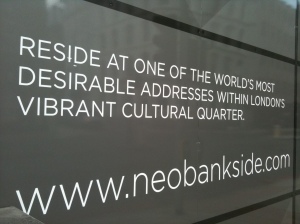The notion of the cultural quarter is one that has been around for a while, yet is still being refined. Many cities across the UK have initiated the planning and development of a cultural quarter in an attempt to to stimulate growth and attempt to ‘re-vitalise’ the local economy along the lines of culture, the arts and the creative industries. But are they working? Who are they really for? What kinds are there? Who was involved in their development?

Walking down Tooley St by London Bridge in London the other day, on the boards which separate the construction of more unaffordable condominiums and the asphalt, I saw the words “reside at one of the world’s most desirable addresses within London’s vibrant Cultural Quarter” (pictured). I don’t recall there being a specific policy outlining the South Bank area as London’s cultural quarter – and even if there was, I would imagine that the West End would have a lot to say on the matter. But whoever came up with this property marketing detritus, it is nonetheless a stark reminder of the importance of the idea of a cultural quarter to the regeneration of cities, particular in the UK. If the South Bank is indeed a cultural quarter (which it isn’t, but let’s go with it for a moment), then it is one that is based around the spectacle of consumption. The South Bank Centre of course offers a wide variety of arts and cultural productions, as does the nearby BFI. The restaurants, shops and bars are presumably there just make sure that every ounce of change is vacuumed from the visitors pockets before they go back home for the evening. If the provision of a corporatised quasi-homogeneous view of ‘culture’ is the mainstay of a cultural quarter, then I suppose this area must be. But what about the skateboarders under the causeway? The tracuers who often frequent the top of the South Bank Centre? Or when Hide & Seek come out to play? These sub-cultural activities appropriate this area too, so maybe there is a way in which it can be considered a (sub)cultural quarter… of sorts.
On a recent visit to Sheffield, I was surprised to see that the city had somehow managed to amass 6 quarters, one of which was of course a cultural one. How a city can be quartered into 6 perhaps says as much about the maths skills of the local council as it does their marketing strategy, but it is the cultural quarter, developed and managed by the CIQA which has perhaps had the most effect on the regeneration of the city. The area is home to a number of creative industry businesses and the existing infrastructure is being put to relative good use – the failed National Centre for Popular Music, a Lottery-funded museum for UK pop music which lasted for a measly 15 months before having to shut, is now the Sheffield Hallam Student Union building. The failure however of the flagship museum is being mirrored in other areas of the country. Leicester’s Curve theatre, the major invested venue for the city’s cultural quarter is losing a load of money and the visitor figures are not stacking up. Will these local-council driven, one-flagship-centre-piece-orientated cultural policy “disasters” (not my words) be the unfortunate hallmark of the ‘cultural quarter’ in the UK?
There are other cultural quarters in the UK and across Europe, some of them production driven – in that they are attempts to stimulate production of culture with business space for creative industry activity and maybe a couple of major venues – others are consumption driven (such as Brighton’s ‘boutique and unique retail area‘ of North Laines) which are devoted to retail. Most of course will be a mixture of the two. Whatever the utility, there is a growing consensus that cities need to develop a cultural quarter. Visitors to these cities are apparently asking, “where can I consume culture?” and so need to be directed by a brown tourism sign. Is this how we want to package culture in our cities? Can we confine it to a ‘quarter’ of the city? Would not the whole a city, including inner-city deprived neighbourhoods benefit from a more considered and ‘grass-roots’ approach to culture? Should we not start perhaps with who is struggling to produce cultural goods already (rather than trying to bus it in from the ether) in the city and encourage them? Maybe, maybe not, but it might be worth someone taking a punt to find out sometime….
P.S: I’ve started a Google Map in an attempt to document the UK’s growing use of ‘cultural quarters’. If your city has one (I’m thinking UK presently but of course any examples will suffice) then let me know some details about it (drop me an email or tweet) and I’ll add it to the map.
Leave a comment